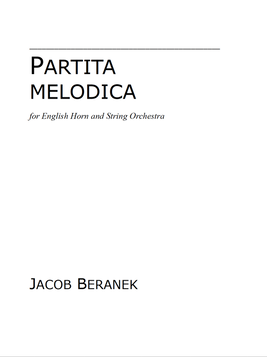PARTITA MELODICA (2018)
English horn, string orchestra
English horn, string orchestra
PROGRAM NOTES
When I started to conceive this work, the word partita came to mind from the first note. Although the term is often associated with Bach’s dance suites, partita literally means “divided off” or “separated,” and therefore only signifies a composition that is divided into multiple movements, nothing more. Having written a lot of programmatic music lately, I wanted to use this piece as an opportunity to move away from explicit narrative and instead try to hold the audience’s attention via purely musical means. A “partita” fit this concept perfectly, and for a bit of descriptive flair, I added the qualifier “melodica.” Compositionally speaking, my primary focus while writing this piece was to improve my sense of harmony and harmonic language, but also to develop my unabashed love of melody. While I’ve been writing “tunes” for ten years, I made it one of my missions this past year to delve into a more thorough study of melodic line and employ it in my music. What better way to test (and expose) myself than a partita melodica?
The opening movement, Prelude, sets the scene and establishes the lyrical scope of the work. The middle movement, Romanza, explores a wide-range of emotions, and after building to a climax, releases to a cadenza-like section. As the energy builds, the music transitions directly into the lively, dancelike Rondo, paying homage to the partita’s history. Utilizing previous motivic material in the B and C themes, the movement cyclically concludes with the second and first themes from the Prelude, before one last soloistic flair from the English horn rounds out the work in jubilant celebration.
—Jacob Beranek
When I started to conceive this work, the word partita came to mind from the first note. Although the term is often associated with Bach’s dance suites, partita literally means “divided off” or “separated,” and therefore only signifies a composition that is divided into multiple movements, nothing more. Having written a lot of programmatic music lately, I wanted to use this piece as an opportunity to move away from explicit narrative and instead try to hold the audience’s attention via purely musical means. A “partita” fit this concept perfectly, and for a bit of descriptive flair, I added the qualifier “melodica.” Compositionally speaking, my primary focus while writing this piece was to improve my sense of harmony and harmonic language, but also to develop my unabashed love of melody. While I’ve been writing “tunes” for ten years, I made it one of my missions this past year to delve into a more thorough study of melodic line and employ it in my music. What better way to test (and expose) myself than a partita melodica?
The opening movement, Prelude, sets the scene and establishes the lyrical scope of the work. The middle movement, Romanza, explores a wide-range of emotions, and after building to a climax, releases to a cadenza-like section. As the energy builds, the music transitions directly into the lively, dancelike Rondo, paying homage to the partita’s history. Utilizing previous motivic material in the B and C themes, the movement cyclically concludes with the second and first themes from the Prelude, before one last soloistic flair from the English horn rounds out the work in jubilant celebration.
—Jacob Beranek


